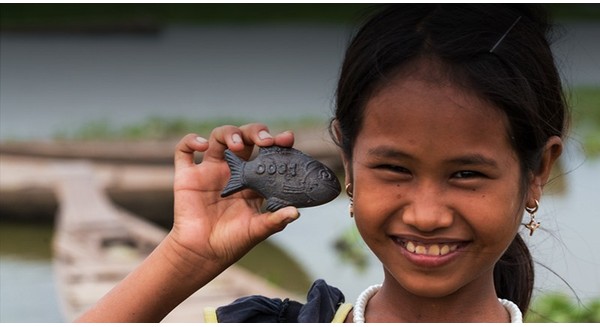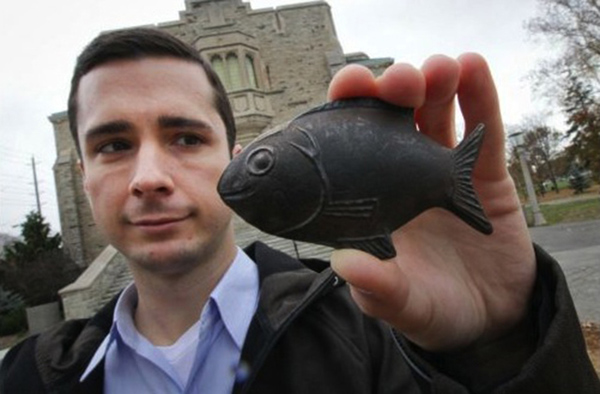Learning about fish with Lucky Fish helps prevent anemia
Refer to the documentation and explain more about the development of this Lucky Fish as well as the benefits it brings.
The fish with Lucky Fish helps prevent anemia
After the article " Fish with Lucky Fish iron helps prevent anemia for people in poor countries, difficult living conditions" posted. Some opinions suggest whether that is true, iron fish may supplement iron for humans, use fish safely, etc. Now, please refer to the document and explain more about development of this fish as well as the benefits it brings.

"You can have the best treatments in the world, but if people don't use it, it's nothing."

Canadian doctor Christopher Charles and the Lucky Fish iron fish he developed
Realizing that the iron plate could not create appeal for the people to use, Charles and the team used iron cast to create a lotus shape. However, the villagers continued to reject this form. After consulting with the village seniors, Charles discovered that the fish image of the inhabitants here seemed to symbolize luck, health and happiness. Therefore, they used iron ingot to create a fish shape and succeeded.
The villagers were more sympathetic to this product and after a while of using it, iron fish quickly increased the concentration of iron in people's blood and anemia was completely removed.
Clinical trials continued to be carried out from September 2008 to February 2009, and the results showed that the blood levels of iron in people taking iron fish had increased in at least 3 months.
However, continued use does not significantly increase the amount of iron in the blood. The study was conducted from the end of the rainy season to the beginning of the dry season. At that time, villagers had accumulated rain water to use gradually in the dry season. In the study area, the team found that the water pipes make the arsenic and manganese concentrations in water very high, affecting the presence of iron, thereby isolating iron from being absorbed into the body through food. . Realizing that the difference in water quality is a confounding factor, they conducted a second study to control this issue.
Finally, the team came to the conclusion that compared to blood iron levels before the test, individuals using iron fish had an increased blood iron concentration after 12 months of use and anemia rate. 43% reduction.
Production cost of 5 dollars each. Sold $ 25, 1 child, 3 children are given free to Cambodian people

In December 2012, Dr. Gavin Armstrong, a doctor at Guelph University, officially founded Lucky Iron Fish Project to commercialize iron fish. The company took advantage of iron scrap from a local factory, then recycle to produce Lucky Fish.
Next, the company stepped up its product introduction in rural villages in October 2013 and started a promotional campaign in Kandai province, Cambodia in January 2014. t
As of 2011, each fish has a production cost of about US $ 1.2. By May 2014, the company announced it had raised more than $ 690,000 and would produce a series of Lucky Fish for $ 4 each. After receiving US $ 1.1 million from private investors, the company supplied 11,000 fish to non-governmental organizations in the first five months of 2014.
They will sell fish to everyone, can buy it for use or give it to others. In addition, they plan to sell Lucky Fish in Canada for $ 25 each.
On April 28, 2014, the company stated in a press release that it obtained B Corporation certification and established a non-profit organization in the United States.
How to use: Boil for 10 minutes with food, add lemon to increase the absorption of iron in the intestine

Each Lucky Fish is 7.6 cm long and weighs 200 grams. It is placed in the cooking pot and a little lemon is added and cooked for 10 minutes with 1 liter of water. Lemon juice will enhance intestinal iron absorption . Fish can also be cooked with rice or stews if desired.
The number of people who use fish regularly is 92% and even many of them introduce their relatives and friends as a symbol of luck. The pieces of iron ingots are designed to have the surface spreading the maximum iron during cooking, thereby maximizing the amount of iron removed from the fish to the food or drink of the people.
This is considered to be a special feature: when it comes to high temperatures in a predetermined time, it will release the right amount of iron by the amount of iron required in the standard diet.
The results show that, on average, people using fish will ensure 75% of the iron in the daily diet as recommended. They said that iron does not change the taste of water or food.
The project hopes to collaborate with young people in Cambodia to promote more accessible projects as older residents often have high levels of illiteracy, especially in remote rural areas. .
Question : Can other iron objects be used to replace Lucky Fish?

Going through the comment pages, I find many of you wonder if the 25-dollar iron fish (about 500 thousand dong) is still too expensive for many people to earn. More interesting is that some of you even think that why not take the normal iron , iron pieces or even nails to put in the cooking pot.
Firstly, according to the above study, if households use cast iron, iron to cook food, combined with iron-rich foods, the rate of iron deficiency can be reduced, from which the anemia rate of They are not high. While many poor people in Cambodia and elsewhere cannot access it, the Lucky Fish was used . It is the case of using cast iron pots.
Now, the kind of iron bought at a normal shop, even an iron nail , cannot guarantee health . Why? In addition to iron, because these are industrial products, there may be additional heavy metals such as lead, nilken, cobalt, and arsenic, all of which are toxic to the human body.
Moreover, the design of the fish has been optimized so that when it comes to heat, the amount of iron spreading to the food is the same as recommended in the diet so it is possible to replace it with another shape without prior calculation. then the efficiency will not be equal.
A bit of history
According to statistics, about 60% of pregnant women in Cambodia suffer from anemia due mainly to iron deficiency in food, leading to hemorrhage due to premature birth and early birth. This increases the incidence of brain development problems in children. Iron deficiency is classified as the "most common nutritional disorder " in Cambodia, affecting 44% of the population and causing $ 70 billion in annual gross domestic product (GPD) loss.
In May 2015, Christopher Charles just graduated from biomedical sciences at the University of Guelph, Canada. At that time, Charles received funding from the Canadian International Development Agency (CIDA) to conduct epidemiological research in Cambodia. Charles chose Cambodia because it was a country that needed volunteers and researchers to build a diet full of iron. Upon arriving in Cambodia, Charles worked at the Preak Russei research center and proceeded to collect blood samples from the villagers in Kandai province.
Previously, it was known that cast iron pans were one of the ways to add iron to food during cooking. However, with incomes of less than $ 1 a day for many rural people in Cambodia, this is a luxury item. Even foods that are a source of iron, such as red meat, iron beans, or micronutrient supplements, are even more inaccessible.
Therefore, the team provided iron plates to the people here, and asked them to put the dish on the pot while cooking soup or boiling drinking water. However, many women here are reluctant to ask to use this iron plate while cooking. Even many people refuse to use it. Charles shared that this is a social marketing challenge.
A few weeks before completing his studies and returning to Canada to complete a master's degree, Charles called the counselor, Dr. Alastair Summerlee, to delay. Summerlee also advised Charles to focus on an anemic and unexpected research project, which is Charles's doctoral thesis.
- Miraculous fish fever in Cambodia
- Iron fish cure anemia for Cambodians
- Young anemia and identification signs
- Benefits when eating bananas
- Fish also love massage
- What should anemia eat to stay healthy?
- Miraculous food prevents cancer, high blood pressure
- New hope for patients with Mediterranean anemia
- Using stem cells to treat genetic anemia
- Why often lucky money sheets 2 USD in Tet?
- Gene therapy can help patients with anemia
- Low vitamin D increases the risk of anemia in children
 'Fine laughs' - Scary and painful torture in ancient times
'Fine laughs' - Scary and painful torture in ancient times The sequence of numbers 142857 of the Egyptian pyramids is known as the strangest number in the world - Why?
The sequence of numbers 142857 of the Egyptian pyramids is known as the strangest number in the world - Why? History of the iron
History of the iron What is alum?
What is alum?